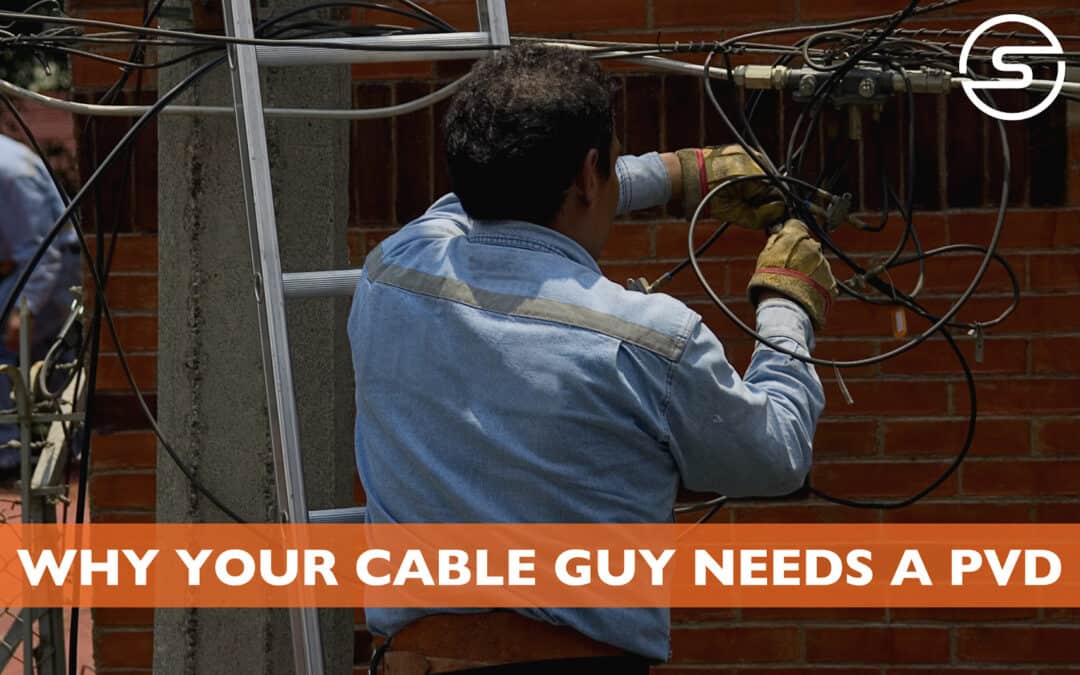Why Your Cable Guy Needs a PVD
Have you ever considered all the utility services you rely on at home? They provide you with many conveniences you take for granted: running water, electricity, and cable TV, to name a few. Some, like natural gas and water, are underground. But several of them, including electricity, telephone, internet, and cable TV services, are brought to you by a vast network of wires and cables mounted and strung on power poles that dot the country from coast to coast.
Believe it or not, utility poles have been around since the early 1800s, when they were used for telegraph lines. Although many new property developments now bury lines in conduits, power poles are still more prevalent. Utility poles are pretty cost-effective and efficient. History shows that poles can adapt to new technologies, from the telegraph to the internet. Utility poles also make it relatively easy to extend utilities to new locations.
Utility poles, however, come with a considerable safety risk: exposure to high voltage. Every new service that utilizes power poles means new workers will be exposed, including your cable TV installer.
Cable TV Installers Are Exposed to Energized Lines
Even though the cables used to bring cable TV to your home are insulated, it does not mean your cable installer is safe. The power lines that carry electricity down the street to your home can carry 10,000 volts or more (major transmission lines carry much higher voltages), and your cable installer will work close to these lines when stringing your cable lines.
Accidental contact with high voltage lines is a primary cause of injury for workers who work around power lines, not just for line workers, telecommunications workers, and tree trimmers, but for your cable guy, as well. Direct contact almost invariably leads to severe injury or even death. But more than that, there is danger every time you get near high-voltage lines.
In other words, direct contact is unnecessary to sustain serious injuries or even suffer electrocution. High voltage lines emit an electrical field, and electricity can “jump” from a wire to a person if a person is close enough. In addition, mist, moisture, or smoke in the air can be conductive, and even air itself is not a sufficient barrier, depending on the circumstances. There is an excellent reason for those “Danger High Voltage” warning signs on the fences surrounding installments of power equipment: even being near high voltage is extremely risky.
Personal Voltage Detectors for Cable Installers
Anyone who works on or around high-voltage lines should use personal protection equipment (PPE) designed for working around energized lines, and your cable installer is no exception. One of the essential items of PPE is a personal voltage detector (PVD) such as the COMPASS PVD from Safeguard Equipment.
The COMPASS line of PVDs detects not only voltage but current. The devices clip onto a standard hard hat or a shirt. COMPASS detectors provide a 360-degree range of detection and emit both an audible and a visual alarm that alerts the wearer to the presence, proximity, and direction of an energized line.
Sometimes, people may think this is unnecessary. After all, these workers are trained to work around energized lines, right? But when you are concentrating on a particular job at hand, you can sometimes lose situational awareness. Moreover, many electrical accidents happen because workers assume a line is de-energized when it is still live or think they are in the clear when they aren’t.
Electrical injuries are not like other work injuries. They can be debilitating and deadly and create dangerous situations for those around them. If worker safety and zero work injuries or accidents are your goals, you need PVDs for your cable installers.
The new COMPASS Pro, with the integrated Safeguard Equipment App, is especially critical if your cable installers are working alone. The COMPASS Pro device can detect arc flashes, falls, and man-down events. When coupled with the App, the product provides a direct communication link between your worker and the home office, alerting your designated safety team that one of your workers has had an adverse electrical injury event. The COMPASS Pro enables you to summon emergency services immediately if your worker fails to respond.
To find out more about the COMPASS G2 or the new COMPASS Pro emergency response solution, or to see a demonstration of these products, contact Safeguard Equipment today.
Views: 6

